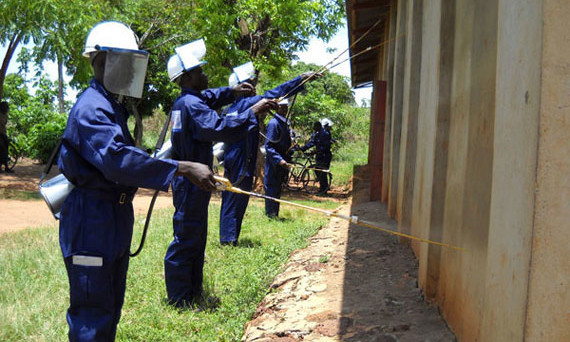
Uganda has markedly increased access to – and use of – malaria interventions since 2007, likely driving the country’s 58% decline in malaria mortality from 2000 to 2013. Yet with the massive malaria outbreak in northern Uganda this summer, during which government officials reported over 22,000 cases and 160 fatalities in three months, the need for strong, regular monitoring of local malaria trends has become more urgent.
Nationally, less than 15% of households owned insecticide-treated nets (ITNs) or had their walls sprayed with an insecticide solution (indoor residual spraying [IRS]) in 2005. Six years later, according to a team of researchers from Uganda’s Infectious Diseases Research Collaboration (IDRC) and the Institute for Health Metrics and Evaluation (IHME), coverage rose nearly five-fold, climbing to 59%. Across regions, ITN or IRS coverage ranged from 53% in East Central to a high of 82% in the North in 2011.

Historically, northern areas of Uganda have had the highest rates of malaria transmission in the country (and often in the world). In response, the country and development partners have heavily targeted this region for malaria prevention and treatment efforts.
This focus likely underlies the North’s regional gains in malaria intervention coverage: in 2011, its rates of ITN use (56%), coverage of IRS (56%), and receipt of first-line antimalarials by febrile children under 5 (69%) were the highest in Uganda.
And just-published survey data show over 94% of households in the North owned ITNs in 2014 – evidence of success for Uganda’s first universal distribution campaign that took place from May 2013 to August 2014.
So if the North region has made so much progress in scaling up malaria interventions, why did it experience such a devastating outbreak this year? Ugandan leadership points to a number of potential factors, including the recent cessation of IRS in some districts and less consistent use of malaria interventions among certain communities.
Unfortunately, the latter is not rare when countries are successful in reducing their malaria burdens; as the actual risk for malaria falls, perceptions of risk and continued need for interventions can also decline. Further, researchers have shown that malaria can often resurge following shifts in or downsizing of control programs.
In combination, these regional results and recent developments in Uganda’s fight against malaria point to two main priorities going forward. First, regular monitoring of localized malaria trends is needed to further strengthen responsiveness to outbreaks and intervention needs.
Generating yearly estimates of health outcomes and intervention coverage at the regional level was an important first step in improving subnational benchmarking efforts. Expanded district-level data collection and fine-grained geospatial analyses would help guide more targeted deployment of resources against malaria.
Uganda has achieved large gains against malaria through improving intervention delivery. At the same time, this year’s outbreak in northern Uganda highlights a need for stronger, more focal monitoring of malaria needs.
For instance, amid the recent outbreak, Uganda’s National Malaria Control Programme (NMCP) introduced district-level malaria maps to bolster local surveillance and launched guidelines to strengthen epidemic preparedness and response.
Second, identifying the right combinations of malaria interventions – and providing them to the right places and people at the right times – is likely needed to further reduce Uganda’s malaria burden. The country’s latest malaria strategic plan outlines mechanisms for the NMCP and development partners, such as the President’s Malaria Initiative and the Global Fund to Fight AIDS, Tuberculosis and Malaria, to strengthen coordination across a spectrum of tools against malaria. In addition to ITNs and IRS, Uganda is also considering complementary approaches to vector control, such as improved home construction.
Uganda has achieved large gains against malaria through improving intervention delivery. At the same time, this year’s outbreak in northern Uganda highlights a need for stronger, more focal monitoring of malaria needs.
No magic bullet exists against malaria, nor will a one-size-fits-all solution work to end the disease. But by harnessing local evidence and devising multipronged, targeted programs, Uganda aims to accelerate toward its goal of reaching zero malaria.
Comments